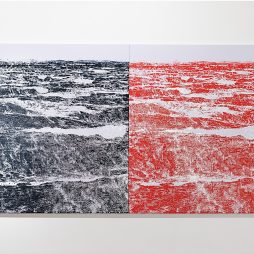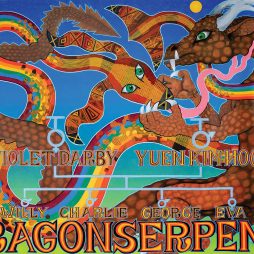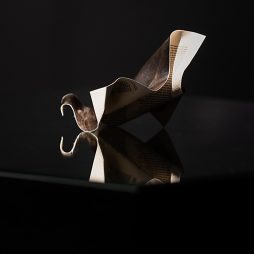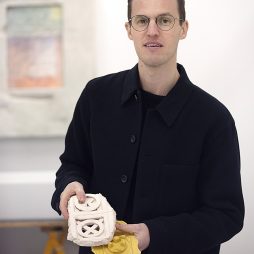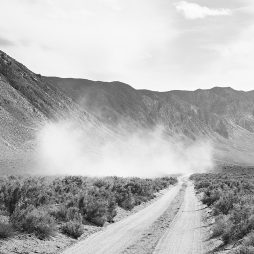Cinderella Man, Archie Moore (Bigambul-Kamilaroi)
I’m a stranger in my country
I’m a stranger in my land
Today someone no account
Tomorrow, something grand,
Vic Simms of La Perouse, The Loner, 1973
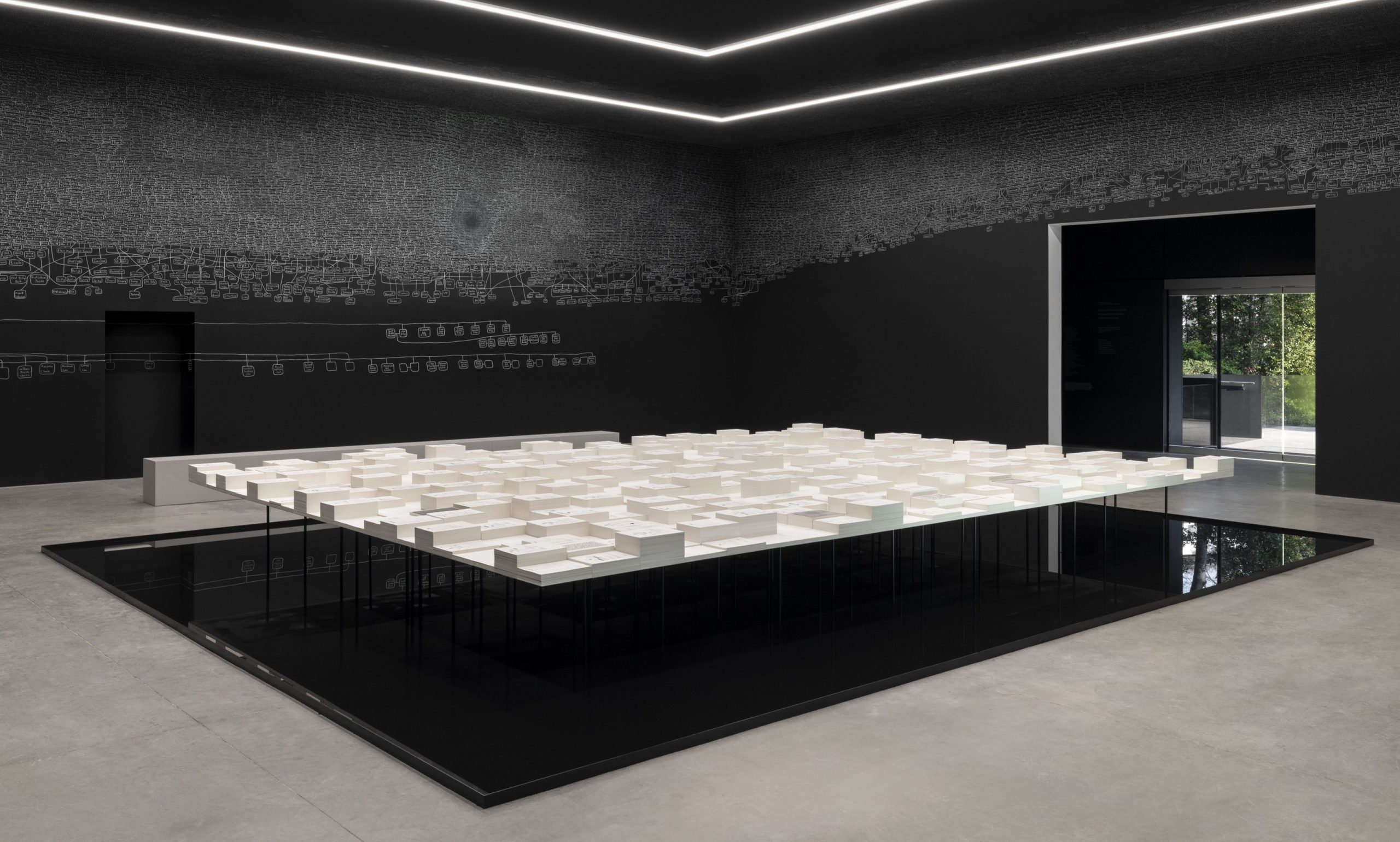
The year 2024 is a special year as Australia somewhat confidently readies for the approaching Olympic Games in Paris. The national society feels it has a proud sporting record, if lacking in balance of achievements in intellectual, cultural, and moral terms. A form of cultural cringe perhaps. Lieutenant Cook didn’t discover our continent but did name the prison-colony South Wales, and New South Wales, after similar beaches in south Wales to beaches on our continent’s east coast. The year 2024 is the bicentenary of the official usage of the European word Australia by Matthew Flinders—from the Latin word Australis meaning southern—to name the entire continent.
This year, artist Archie Moore’s kith and kin family tree installation this, in a national and international first and a personal, well deserved, “rags to riches” story, won the Golden Lion for Best National Participation at the 60th Venice Biennale, the visual art world’s preeminent event. Moore had worked on several forms of this autobiographical installation, growing larger and larger from a concept in 2018, imagined on an island in a river mouth outside Brisbane—a mirror image of early Venice on the other side of the world.
I’d come to fully meet a quiet, shy, Archie Moore some twenty years ago, and we’ve kept up conversations here and there, serious conversations, and picked up on each other’s quirky research and obsessions, and our own forms of seeing the world. I’d really admired his view of the world, of searching out “left of field sources,” and I’ve seen a progression of exhibitions and artworks that have become more explicit, more complex, and profound.
Moore (Bigambul-Kamilaroi) was born in 1970 in regional Toowoomba and grew up in a poverty-stricken family life in Tara to the west. Despite his early life, the 1990s found him completing a bachelor of visual arts at Queensland University of Technology in an exciting, “hot” rebirth scene of Queensland Indigenous cultural life.
Artist Archie Moore was named after the immortal African American boxer Archie Moore (1913-1998). Boxer Archie Moore was the longest successfully participating boxer in the game. He had been consistently ranked as third or fourth, pound for pound boxer in history. Although he never spoke of sport to me, artist Archie Moore told me of how this personal title lifted his self-esteem in the cruel, empty life in regional Queensland.
I was fortunate to have been invited to write the kith and kin essay for the Venice Biennale, 2024. In that essay I explained that “in many country regions of Australia, you are told: ‘There were no Aboriginal people living here’ or that ‘there are a few, but they’re not, really, Aboriginal people (of mixed descent). . .Colonisation travelled through three moves or stages: at first cursory meetings, then, as the actual colonial intent becomes clear, resistance and violence ensues, and in the Australian context, an attempt at annihilation of the Indigenous population begins. This ‘move’ has been described heroically as ‘clearing the land,’ or ‘dispersing’ the Indigenous populations. The surviving Aboriginal population, legally redefined, disempowered and displaced onto restricted lands (reservations) and given over to care of Christian missionaries to be re-educated and ‘civilized’ in the European model. No matter whatever the missionary, denomination, character, type, or form, their aim to the present day, is to break the inter-generational bond. . .those not legally allowed to live on reserves. . .lived in shanty towns on the fringes of ‘white Australian’ society.”
Moore would conduct his own beautifully constructed art object literature survey of Christian superior beliefs in Humpy Goona, 2010, that won him the Woollahra Small Sculpture Prize in 2010.
Aboriginal people were legally defined by state and national government in a series of Aboriginal Protection Acts by bloodline and skin tone: as full-blood, half-caste, quarter-caste, octeroon, and so on, with decreasing respect and increasing social disdain. Moore commented that “I was quiet and reserved as a teenager, I didn’t want people to see me as an Aboriginal, as a declaration, that could invite being attacked—even so I didn’t want to stand out and invite scrutiny.” Moore would return to this disempowerment of being a specimen in his 2022 skin tone comment, Mial—a form of racist defining used everywhere by oppressive regimes from South Africa to in Scandinavia. The wider unofficial Australian population generally had their own derogative racist labels: black gin, poor black fellah, abo, boong, sambo, vegemite, licorice, golliwog, chocolate, bomba, dusty, marbuk, black-velvet, black stud, black bird, nigger, coon; and yellah-fellah, half-a-colour, myal (mial), and half-breed, were common, seemingly endless, and widespread. Moore was further burdened—his teacher nick-named him “Speedy,” after his laconic manner of speaking. This sense of derision, insult, and sense of lack of identity were telling on his psyche.
***
“I was unhappy for a long time, and very lonesome, living with my grandmother. Then it was that books began to happen to me, and I began to believe in nothing but books and the wonderful world in books—where if people suffered, they suffered in beautiful language, not in monosyllables, as we did in Kansas.” Langston Hughes, The Big Sea, 1940.
It’s strongly felt from his conversations that the artist Archie Moore found solace and inspiration in books, reading, movies, and music. Despite the jibes and sarcastic comments, it was here in a true intellectual desert (the small town of his birth and another living) that Archie discovered books and reading and, like Tracey Moffatt and many other Aboriginal artists, escaped into other people’s stories.
The artwork of Moore’s career, has throughout, been created around ideas, inviting the audience to interact through all our senses, and to be directly experiential rather than solely a “visual art” object on a white gallery wall; but remains pointedly powerfully politically loaded. Moore paints but plays on the invisible; smell, taste, touch, sound, as much as sight, and even here interrogates text to numerous meanings across nations, race, and class. In all these constructions remaking his own personality and identity; as in the series Les Eaux d’Amoore, 2014, like the orphaned child in Patrick Süskind’s Perfume novel from 1985, telling his life story through encountered scent. And the central inherent race division of one’s scent; the epithet; you stink!
***
“I don’t care really; this is my experience . . . I don’t want people to be depressed or guilty. I want them to have an in my shoes, to share experience.” Archie Moore, 2023.
The Venice Biennale was set up around the same time as the re-emergence of the modern Olympic Games and obliquely as an Olympics of art / cultural where artists appear as national representatives and not as individual practitioners. Well, you know there can never really be an Olympics of pain or trauma, winning gold for injustice, murder, killing, or being a victim. In 2024 against this nation-state profile, both Moore and curator Ellie Buttrose stressed that his statement here in Venice wasn’t a national representation but more from: “My own idiosyncratic self.”
Boxer Archie Moore had a long match list of some of boxing’s most memorable events. And although artist Archie Moore may have appeared not as renowned as his Brisbane contemporaries, like his namesake, his continuously thoughtful, meaningful, political, mentally, and emotionally constructed art pieces really take your breath away. It isn’t an accident he was honored in Venice.
“I’m good at going backwards,” says Moore. In the last few years, Moore conducted his own impressive, relentless personal extensive research back into his family tree. His investigations included official records, interviews with relatives and contacts. They affirmed his Aboriginal antecedents and a clarity to his identity (Bigambul-Kamilaroi). It also located his place in the Indigenous family tree, a consciousness of the human family tree and the family tree of all life on earth.
In 2000, while in St. Petersburg with Wally Caruana’s The World of Dreamings exhibition presented by the National Gallery of Australia and the National Museum of Australia at the Hermitage Museum, artist Fiona Foley and I were taken on a popular tourist trip to the scene of the historical figure, the monk Rasputin’s murder in 1916. In a clumsy bungled crime, despite the monk being poisoned, shot, and dumped weighted in the ice-covered Niva river, his body returned to the surface to reveal the conspirator’s crime. The concluding work of kith and kin is a pond in which over 500 copies of the never-ending Aboriginal Deaths in Custody Royal Commissions, investigations, other records including an incident in Archie’s own family, that seemingly float on the water in plain sight, demanding to be actioned.
Entering the quiet dark solemn space of the black cube of the Australian pavilion, your eyes at first focus on the illuminated white square. There is a table covered with over 500 reports on Aboriginal deaths in custody that resemble tumbled over headstones in a remote commoner’s graveyard—a quiet graveyard, a sound shadow in a battle zone of the continuing colonial war. The table floats on water; legal facts tied to felt emotion, and on one side through a low window water flows silently in the canal outside. From there your eyes move to a shimmering white mist, a white spider’s web of names wrapping the complete length and breadth of every matt black wall, right up, even covering the ceiling. You’re surrounded by seemingly thousands of names—eyes of the First Peoples’ dead, murdered in the mechanical colonisation of the Australian continent. Large empty black circles, seemingly brushed out in the record are times of smallpox plagues, massacres, and records destroyed by fire, neglect, or theft of funds, and counterbalance the web of names, and pronounce the idea of a net, a punctured web. As you stand in the light next to the white “graveyard” of unacted orders, you can feel the weight of the intense painful, sorrowful, pleading, yet warm gaze. What do you now know and remember? What will you be moved to do? I was moved to tears. As were many others.
This article first appeared in Artist Profile Issue 68. Image courtesy of the artist and The Commercial, Sydney.
Djon Mundine OAM FAHA is a Bandjalung man, curator, writer, artist and activist
EXHIBITION
Archie Moore: kith and kin
27 Sep 2025 – 18 Oct 2026
Queensland Art Gallery | Gallery of Modern Art


